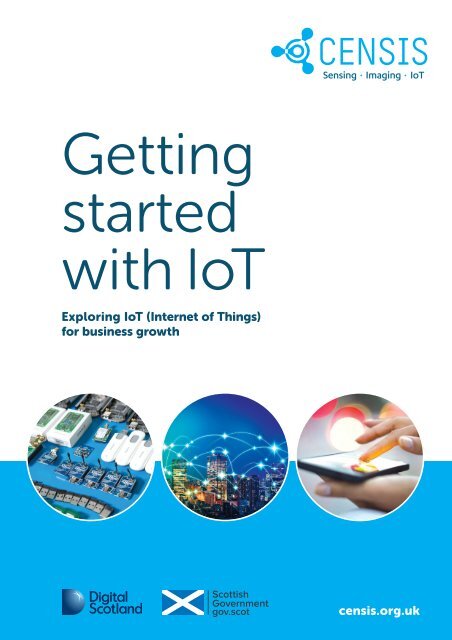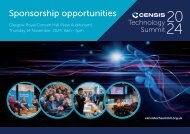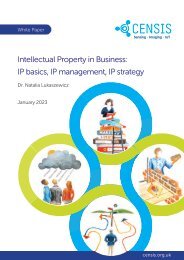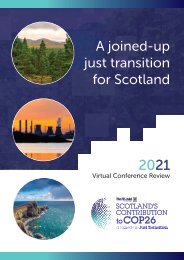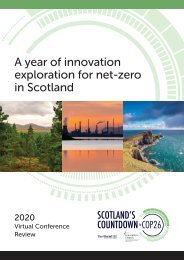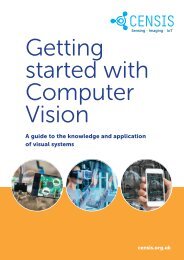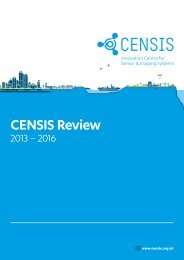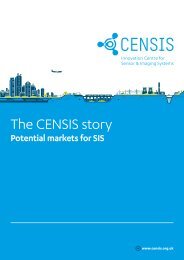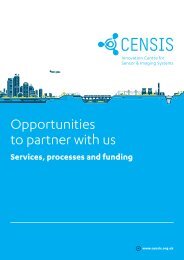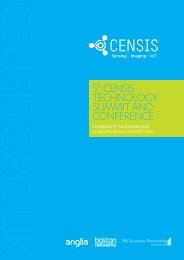Getting started with IoT
IoT is here and it's time for organisations across the country to take advantage of the transformational benefits of the technologies and expertise available. CENSIS explores IoT for business growth in this IoT starter guide. censis.org.uk
IoT is here and it's time for organisations across the country to take advantage of the transformational benefits of the technologies and expertise available. CENSIS explores IoT for business growth in this IoT starter guide. censis.org.uk
Create successful ePaper yourself
Turn your PDF publications into a flip-book with our unique Google optimized e-Paper software.
<strong>Getting</strong><br />
<strong>started</strong><br />
<strong>with</strong> <strong>IoT</strong><br />
Exploring <strong>IoT</strong> (Internet of Things)<br />
for business growth<br />
censis.org.uk
There’s a transformation<br />
taking place in how businesses,<br />
societies and individuals work<br />
and a new era of possibility<br />
is now producing ideas and<br />
insights we never would have<br />
thought realistic only a few<br />
years ago.<br />
1
Integrating <strong>IoT</strong><br />
<strong>IoT</strong> is here and it’s time for organisations across the country to take advantage<br />
of the transformational benefits of the technologies and expertise available.<br />
<strong>IoT</strong> is a game-changer, allowing companies to create new products and services or<br />
implement cost and time-saving efficiencies using data and insights gathered in<br />
real-time. Environmental, health and social care <strong>IoT</strong> applications will also have positive<br />
impacts on society.<br />
The availability and low price of sensors, coupled <strong>with</strong> major leaps in data storage and<br />
computing capabilities, means that the time is right for businesses to embrace the<br />
major improvements, new opportunities and cost savings that <strong>IoT</strong> offers.<br />
Contents<br />
An introduction to <strong>IoT</strong> 3<br />
• The road to <strong>IoT</strong> 4<br />
• Benefits for business, industry and society 5<br />
• Security 5<br />
<strong>IoT</strong> in action 6<br />
• Example application areas for <strong>IoT</strong> 7<br />
• How a typical <strong>IoT</strong> system works 9<br />
• Industrial <strong>IoT</strong> (I<strong>IoT</strong>) 10<br />
Business models 11<br />
• Software as a Service (SaaS) 11<br />
• Hardware as a Service (HaaS) 11<br />
• Emerging business models 12<br />
The CENSIS <strong>IoT</strong> stack 13<br />
• Sensors 14<br />
• Microcontrollers, edge and embedded computing 15<br />
• Communications, networking and wireless technologies 16<br />
• Data repository 19<br />
• Analysis and post processing 19<br />
• Visualisation and presentation 19<br />
Implementing <strong>IoT</strong> 20<br />
• Finding <strong>IoT</strong> expertise 21<br />
• Your first prototype 21<br />
• Joining the <strong>IoT</strong> community in Scotland 21<br />
Glossary 22<br />
Text <strong>with</strong> an explanation in the Glossary on P22 is underlined the first time it is used.<br />
If you are reading the printed version of this brochure, you can download a hyperlinked pdf at censis.org.uk/brochures<br />
2
An introduction<br />
to Internet of<br />
Things (<strong>IoT</strong>)<br />
Q What exactly does ‘Internet of Things’ mean?<br />
A To simplify the vast amount of chat and hype around <strong>IoT</strong>,<br />
think of it in its broadest sense as: ‘A system of things using<br />
the internet or a private network to connect and<br />
communicate <strong>with</strong> each other.’<br />
Q What ‘things’?<br />
A We say ‘things’ but really mean ‘devices’ that are<br />
connected via the internet to each other.<br />
Your phone is probably such a device. Some watches<br />
are internet enabled. Often, you’ll hear ‘smart’ added<br />
to the front of something to indicate that it can<br />
connect to the internet and chat to other devices,<br />
e.g., smartphone, smartwatch, smart lighting. In an<br />
<strong>IoT</strong> network, each device has a unique identifier<br />
and can transmit and/or receive data over a<br />
network connection.<br />
Q But this is nothing new, haven’t devices been<br />
connecting to each other for years?<br />
A Yes, they have. But technology has advanced so<br />
much in recent times that we now have the<br />
capability to connect many more low cost, small,<br />
battery-operated devices to the internet. If we<br />
install a sensor on such a device, the sensor can<br />
first gather data, then send the information<br />
over the internet. This, combined <strong>with</strong> the rise of<br />
low-cost cloud computing is enabling a vast<br />
amount of new opportunities.<br />
Q Do <strong>IoT</strong> devices need to connect to the internet?<br />
A No, it’s quite common for <strong>IoT</strong> to operate in a closed<br />
private network, especially in industrial applications<br />
where control over a full system is required, or<br />
where there is no internet connectivity. Everything is<br />
contained <strong>with</strong>in a private network so that no data<br />
leaves the system.<br />
Q What kind of ‘data’ is collected?<br />
A Sensors detect and measure changes, e.g., changes in<br />
vibration, impact, heat, light, energy, colour, gases and<br />
temperature. So, you can create a system of sensors, all<br />
working together to measure information that is<br />
specifically relevant to your organisation. They measure,<br />
collect data and send it on.<br />
Q Send it on where?<br />
A Usually, the sensor will send the data to a data repository<br />
in ‘the cloud’ or local storage. It is stored, managed and<br />
organised in the cloud then forwarded wherever you want<br />
it to go. If you want to measure air quality in a city centre<br />
street for example, the sensor system could gather the<br />
information, send the data to the cloud for you to then view<br />
the results on your desktop, smartphone or tablet. <strong>IoT</strong> devices<br />
can also receive data which opens up the possibility of<br />
controlling devices such as switching on a light or<br />
changing a display.<br />
Q But aren’t we all drowning in data already? Will the<br />
information be meaningful?<br />
A When the system is designed, software is built in to ensure<br />
that the data is converted to meaningful information.<br />
The sensor system will also be designed to measure the<br />
quality of data required to give value. What you see is a<br />
‘dashboard’ showing exactly the information you want<br />
to measure. You can set parameters to show only<br />
information that will affect decision making, rather than<br />
showing you every measurement. Data analytics can also<br />
be performed on this data to extract trends, anomalies,<br />
and behaviours.<br />
Q Is it private or can other people see the information?<br />
A Only you and those you authorise will be able to see it.<br />
When setting up your system, you can specify the level<br />
of privacy and security you require. We strongly advocate<br />
designing <strong>with</strong> privacy and security in mind from the start<br />
to ensure the system meets the needs of the application<br />
<strong>with</strong>out compromising the integrity of the system.<br />
3
The road to <strong>IoT</strong><br />
From M2M to <strong>IoT</strong><br />
While <strong>IoT</strong> is a relatively new term, machine to machine<br />
communication (M2M) has been around for decades. Starting<br />
<strong>with</strong> the development of the telegraph in the 1830s, through<br />
the first general communications networks such as ARPANET<br />
(the predecessor to the internet) and the explosion of<br />
personal computing beginning in the 1970s, M2M has been<br />
used for monitoring industrial machinery and reporting status<br />
information to a supervisory system. M2M communications<br />
were originally wired systems but the development of<br />
wireless cellular technology in the 1990s saw M2M become<br />
more prevalent.<br />
The term ‘Internet of Things’ was coined by a British<br />
technologist, Kevin Ashton, in 1999. One of the first true<br />
<strong>IoT</strong>-type applications, however, was introduced at Carnegie<br />
Mellon University in Pittsburgh in the early 1980s. Thirsty<br />
computer science graduate students hooked up the campus<br />
vending machine to ARPANET to check if a drink was<br />
available (and cold), before leaving their desks.<br />
The true difference between M2M and <strong>IoT</strong> comes <strong>with</strong> the<br />
proliferation of connected devices, driven by technology<br />
evolutions.<br />
The development of<br />
MEMS technology<br />
has allowed <strong>IoT</strong> devices to<br />
contain smart, low cost, low<br />
power sensors.<br />
Technology evolutions driving <strong>IoT</strong><br />
Computing power<br />
In 1965, computing scientist Gordon Moore, predicted<br />
that the number of transistors in a dense integrated circuit<br />
(microchip) would double every two years. This proved<br />
accurate for decades as more and more powerful<br />
computing capability became available in smaller and<br />
smaller packages. Today a smartphone has more<br />
computing power than all of the NASA computers<br />
used during the Apollo missions.<br />
Computing cost<br />
The exponential increase in microprocessors and<br />
microcontrollers has seen a similar reduction in the<br />
cost of computing power.<br />
Wireless technology<br />
The development of wireless networks such as cellular<br />
(2G, 2.5G, 3G, 4G and now 5G), Wi-Fi, Bluetooth,<br />
LPWAN and Satellite, has made the ‘connected’ part<br />
of ‘connected devices’ easier to implement, as they<br />
eliminate wired connections.<br />
Low power electronics and battery technology<br />
Although computing power density has increased<br />
enormously, improvements in power efficiency of<br />
electronics has meant that the <strong>IoT</strong> devices can be<br />
powered by small batteries for long periods (even years<br />
in some cases). This, together <strong>with</strong> more efficient battery<br />
technology, has led to widespread use of wireless devices.<br />
MEMS Technology<br />
MEMS (Micro-Electro-Mechanical Systems) is a technology<br />
using microfabrication methods to produce tiny (less than<br />
1mm) devices, usually <strong>with</strong> moving parts, which can be<br />
incorporated into sensors and actuators <strong>with</strong> an extremely<br />
small size and cost. Examples of typical sensors in a<br />
smartphone are: gyroscopes, accelerometers and<br />
microphones.<br />
4
Benefits for business,<br />
industry and society<br />
Advances in low power electronics, communications<br />
standards, and increased efficiencies in battery technologies<br />
have heralded a new era for <strong>IoT</strong>. Power efficient, inexpensive<br />
devices <strong>with</strong> a long range of communication are available off<br />
the shelf, allowing all sizes of businesses and organisations,<br />
in all types of sectors, to design and implement an <strong>IoT</strong> solution.<br />
<strong>IoT</strong> enables organisations to have greater visibility into aspects<br />
of their businesses that may have previously been hidden.<br />
This valuable information, often available in real-time, has a<br />
multitude of business benefits.<br />
Efficiency<br />
Better use of time speeds up processes<br />
Safety<br />
People exposed to less<br />
hazardous environments<br />
Productivity<br />
Identify and eliminate process errors<br />
Profitability<br />
Cost savings and increased<br />
productivity leads to<br />
increased profitability<br />
<strong>IoT</strong><br />
Benefits<br />
Society<br />
Monitoring for health and<br />
social care<br />
Environment<br />
Pollution levels, air quality,<br />
flooding alerts<br />
Compliance<br />
New and more effective ways to<br />
monitor and report compliance<br />
requirements<br />
Innovation<br />
New products and service<br />
opportunities or new markets<br />
Business intelligence<br />
Allowing gathering of data to make better<br />
decisions to benefit the organisation<br />
Security<br />
Any device connected to the internet may be vulnerable<br />
to attack, and <strong>IoT</strong> devices are no different. It is essential that<br />
each device is properly protected <strong>with</strong> security designed in<br />
from the initial concept of an <strong>IoT</strong> project. Secure protocols<br />
should be put in place and rigorous testing carried out<br />
before use.<br />
The UK is investigating a plan to increase cyber security<br />
across consumer <strong>IoT</strong> devices <strong>with</strong> requirements from<br />
manufacturers to build in security features and label devices<br />
so consumers have information about how secure their<br />
devices are.<br />
UK Government cyber security information:<br />
https://www.gov.uk/government/collections/secure-by-design<br />
For more cyber security information go to: censis.org.uk<br />
Studies show that <strong>with</strong> improved security,<br />
businesses would not only buy more <strong>IoT</strong><br />
devices, they would pay 22% more for them.<br />
The <strong>IoT</strong> cyber security market is forecast to<br />
grow to around $11 billion by 2025 1 .<br />
1<br />
Bain & Company ‘Cybersecurity is the Key to Unlocking Demand in the Internet of Things. Syed Ali, Ann Bosche and Frank Ford 2018<br />
5
<strong>IoT</strong> in action<br />
Since 2016, multiple <strong>IoT</strong> networks have been rolling out<br />
across Scotland, laying the groundwork for businesses,<br />
societies and individuals to create <strong>IoT</strong> efficiencies, services<br />
and products. These networks cover Low-Power Long-Range<br />
Networks that enable lower cost connectivity and open up<br />
a host of new and exciting use cases. Cellular networks also<br />
have an important part to play in the <strong>IoT</strong> revolution <strong>with</strong><br />
new <strong>IoT</strong> standards emerging that will form an important<br />
part of the upcoming 5G offering.<br />
These new communication infrastructures will be the<br />
backbone of new application development. Impacts from<br />
<strong>IoT</strong> activities will be widespread and will affect every aspect<br />
of our lives.<br />
As well as consumer, retail, personal health and societal<br />
benefits, industry will apply <strong>IoT</strong> to critical infrastructures<br />
such as manufacturing, transportation, agriculture, healthcare<br />
and utilities.<br />
Within Scotland, there is a rich heritage of companies<br />
developing sensor products, and the move into connecting<br />
these products is a natural evolution of the technology.<br />
The Scottish technology development and manufacturing<br />
landscape is well capable of exploring, designing,<br />
building, certifying and manfacturing technology to<br />
achieve worldwide scale.<br />
We want Scotland<br />
to be recognised<br />
internationally as a natural<br />
test bed for innovation<br />
in connectivity which is<br />
why we are investing in<br />
our digital infrastructure.<br />
Kate Forbes MSP<br />
Minister for Public Finance and Digital Economy<br />
Expected growth of <strong>IoT</strong> units installed worldwide<br />
8.4bn<br />
20.4bn<br />
2017 2020<br />
Source: Gartner<br />
https://www.gartner.com/en/newsroom/press-releases/2017-02-07-gartner-says-8-billion-connected-things-will-be-in-use-in-2017-up-31-percent-from-2016<br />
6
Example application areas for <strong>IoT</strong><br />
Parking in cities<br />
Food production and farming<br />
Challenge:<br />
To optimise the use of parking spaces in cities to<br />
minimise congestion and maximise income<br />
Could an <strong>IoT</strong> system solve this?<br />
An <strong>IoT</strong> system could manage parking spaces to the<br />
benefit of the land owners, drivers and the environment<br />
Method:<br />
Sensors are embedded into the ground or mounted on<br />
nearby buildings to determine whether parking spaces<br />
are empty.<br />
Result:<br />
Via a mobile device, drivers are directed to a space<br />
<strong>with</strong>out having to spend time looking for one.<br />
Parking space owners (private or public sector)<br />
manage land and space more effectively and<br />
ensure maximum revenue. Vehicle emissions are<br />
reduced when drivers no longer need to spend<br />
time driving around looking for a parking space.<br />
Challenge:<br />
To optimise irrigation in agriculture and horticulture. Over<br />
or under watering a crop can reduce yield quality and<br />
potentially waste water, thereby impacting a farmer’s<br />
profit margins.<br />
Could an <strong>IoT</strong> system solve this?<br />
An <strong>IoT</strong> system could ensure crops are grown in<br />
optimum conditions.<br />
Method:<br />
Soil moisture sensors are placed around a field to measure<br />
the level of water in the soil. At regular intervals, the soil<br />
sensors wirelessly transmit readings to the cloud, where<br />
the data is stored and information transmitted to a dashboard.<br />
Result:<br />
From the dashboard, the farmer sees the current soil moisture<br />
and determines if the crops need to be watered.<br />
If the cloud application detects that crops are underwatered,<br />
it could turn on the irrigation system and water<br />
the crops automatically, saving the farmer time.<br />
If the system retrieves the local weather forecast it can also<br />
disable watering if rain is forecast to prevent over watering.<br />
Efficient buildings and hospitals<br />
Home telecare and health monitoring<br />
Challenge:<br />
To monitor the ‘health’ of buildings and improve their<br />
utilisation. Estate managers and building owners often<br />
have little control over the heating, lighting and<br />
occupancy of large buildings. This wastes energy and<br />
increases costs.<br />
Could an <strong>IoT</strong> system solve this?<br />
An <strong>IoT</strong> system could help them better manage<br />
their buildings.<br />
Method:<br />
Sensors placed in rooms assess when rooms are empty<br />
or in use. At the same time, they monitor temperature<br />
conditions, humidity and carbon dioxide, noise and<br />
light levels.<br />
Result:<br />
Building managers adjust room comfort levels, save on<br />
energy used for lights and heating and make better use<br />
of their facilities. In social housing, this could identify<br />
potential health issues for residents from damp.<br />
Challenge:<br />
To support older people to live independently for as long<br />
as possible. The existing analogue telephone lines for<br />
telecare - currently used by 170k people in Scotland - will<br />
be turned off in 2025. This presents a major opportunity<br />
for the introduction and application of <strong>IoT</strong> and other<br />
digital solutions.<br />
Could an <strong>IoT</strong> system solve this?<br />
<strong>IoT</strong> systems will replace the current non-digital<br />
infrastructure and will help monitor people’s health and<br />
wellbeing in the home.<br />
Method:<br />
<strong>IoT</strong> sensors and communication hubs to be provided to<br />
all people requiring services.<br />
Result:<br />
The <strong>IoT</strong> telecare hubs will provide alarm and health<br />
monitoring services. This infrastructure will enable<br />
advanced monitoring and help to keep people healthy<br />
in their homes for longer.<br />
7
People flow<br />
Challenge:<br />
Counting and understanding the flow of people,<br />
e.g., in buildings, city centres, at sports events and on<br />
public transport. Understanding how groups of<br />
people interact <strong>with</strong> public transport systems could<br />
improve infrastructure planning. Crowd management<br />
at large events could be optimised.<br />
Could an <strong>IoT</strong> system solve this?<br />
Low cost distributed sensors could be deployed<br />
across a transport network to anonymously count<br />
and understand the flow of people.<br />
Method:<br />
There are multiple sensor methods that can be used<br />
to track people using or moving through<br />
a space, e.g.,by measuring footfall<br />
or by using vision systems to<br />
anonymously count people.<br />
Crowd behaviour<br />
Challenge:<br />
Enhancing the visitor experience at historic sites and<br />
tourist attractions .<br />
Could an <strong>IoT</strong> system solve this?<br />
Indoor and outdoor location tracking could guide people<br />
round tourist attractions and cities and give relevant<br />
information at places of interest.<br />
Method:<br />
Small beacon sensors can be placed around attractions<br />
to give people relevant information at set locations<br />
through smartphones or other devices.<br />
Result:<br />
Better visitor experience and understanding of people<br />
flow throughout attractions.<br />
Result:<br />
An understanding of demand/<br />
capacity around the network<br />
can support long-term<br />
transport or infrastructure<br />
planning.<br />
Water monitoring<br />
City waste collection<br />
Challenge:<br />
Monitoring water supplies in large buildings and<br />
distributed estates, particularly in remote and rural<br />
areas. Bacteria in a building’s water system could<br />
cause harm to the occupants.<br />
Could an <strong>IoT</strong> system solve this?<br />
An <strong>IoT</strong> system could check whether water temperature<br />
in pipes could encourage harmful bacteria growth.<br />
Currently, many water quality tests are conducted<br />
manually. Automating this could save time and money,<br />
provide clearer results, and identify trends<br />
Method:<br />
Sensors are deployed throughout the water system<br />
to measure water temperature in real time.<br />
Result:<br />
Water temperatures are recorded around the building<br />
enabling the building owner to reduce risk and report<br />
health and safety compliance.<br />
Challenge:<br />
Optimising resources for waste collection; understanding<br />
when bins are full, or if certain bins do not need to be<br />
emptied.<br />
Could an <strong>IoT</strong> system solve this?<br />
An <strong>IoT</strong> system could detect which containers are full<br />
and plan the route to maximise efficiency.<br />
Method:<br />
Battery-powered ultrasound sensors are fitted to the top<br />
of each container to measure the level of waste and relay<br />
this information back to the dashboard.<br />
Result:<br />
A dashboard shows which containers need emptied<br />
and plans the vehicle route accordingly. In turn, fewer<br />
vehicle emissions helps to reduce environmental impact..<br />
8
How a typical <strong>IoT</strong> system works<br />
Hardware<br />
Communication<br />
network<br />
infrastructure<br />
Software<br />
Devices<br />
such as:<br />
Systems such as:<br />
NB-<strong>IoT</strong> LoRaWan<br />
LTE Cat-M1<br />
LoRaWAN<br />
Cloud<br />
providers<br />
such as:<br />
Secure<br />
IP connection<br />
Gateway<br />
Device Management<br />
HTTPS<br />
Sensors are placed<br />
in relevant areas.<br />
Data is received by a<br />
gateway then sent to the<br />
cloud application.<br />
The cloud application<br />
performs data analytics and<br />
sends to the user interface<br />
(dashboard).<br />
A microcontroller reads the<br />
sensors. The microcontroller<br />
runs from a small battery<br />
and is asleep for most of the<br />
time to conserve energy, only<br />
waking when required to read<br />
the sensors and relay the data<br />
back to the gateway.<br />
Low power wireless<br />
technology will allow the<br />
edge nodes to run from<br />
battery or other power<br />
sources for years.<br />
The value is here!<br />
From the dashboard, the<br />
user can see the real time<br />
results and also trends over<br />
the past days and weeks.<br />
9
Industrial <strong>IoT</strong> (I<strong>IoT</strong>)<br />
You will also hear I<strong>IoT</strong><br />
referred to as Industry<br />
4.0 or Digital Manufacturing.<br />
<strong>IoT</strong> systems can monitor and automate many complex<br />
processes. Manufacturers have begun to recognise that<br />
networks of smart sensors, coupled <strong>with</strong> real-time analytics,<br />
can act as drivers of significant improvements in their processes,<br />
transforming profit margins and operational efficiencies.<br />
Predictive maintenance and<br />
condition monitoring<br />
Challenge<br />
To avoid lengthy, unnecessary shutdowns of critical machinery.<br />
Downtime isn’t only expensive, it can also be a health and<br />
safety risk in some industries such as Oil & Gas where staff<br />
may work in hazardous areas or in lone worker scenarios.<br />
Could an <strong>IoT</strong> system solve this?<br />
An <strong>IoT</strong> system can measure operating conditions such as<br />
temperature and vibration around equipment and detect<br />
when the equipment deviates from its prescribed parameters<br />
– detecting deterioration before failure.<br />
Result<br />
With real-time views of conditions across a factory floor,<br />
hospital, oil rig or wind farm, problems can be identified and<br />
managed before failure occurs. Scheduling maintenance<br />
before something breaks saves time and money.<br />
Asset tracking<br />
Challenge<br />
To maintain an accurate log of key assets. Managing the<br />
location and maintenance schedule of physical assets,<br />
e.g., important, moveable equipment in hospitals, can be<br />
expensive and time consuming.<br />
Could an <strong>IoT</strong> system solve this?<br />
An <strong>IoT</strong> system can track assets in real-time, using RFID tags or<br />
other technology.<br />
Result<br />
Asset locations can be identified and maintenance scheduled<br />
efficiently. This reduces administrative costs and ensures<br />
accountability and accuracy. Some industries require asset<br />
tracking for regulatory compliance.<br />
Expected market growth for asset<br />
tracking <strong>IoT</strong> devices<br />
22m<br />
2017 2022<br />
Integrating sensors across machines and equipment.<br />
Examples could include sensors measuring vibration,<br />
temperature or robot positioning.<br />
Remote management of factory units.<br />
70m<br />
Source:<br />
https://www.prnewswire.com/news-releases/asset-tracking-iot-devicemarket-to-triple-by-2022-300498147.html<br />
Other uses for <strong>IoT</strong> in manufacturing<br />
Introducing wearables such as smart safety glasses or<br />
smart hard hats for employees.<br />
Monitoring production flow in real-time from start to<br />
packaging and distribution. This can highlight quality<br />
control issues and production lags.<br />
Using smart packaging to manage stock control,<br />
automating the ordering process. This can also<br />
provide insights into how the product behaves<br />
during transit, in various weather conditions and how<br />
customers store and use the product.<br />
Connecting to suppliers to track products through<br />
the manufacturing cycle in the supply chain.<br />
Using data collected to analyse how customers<br />
use products, feeding innovation for new product<br />
development.<br />
10
Business models<br />
The evolution of <strong>IoT</strong> has led to the emergence of new business models. The rise of the data driven economy is enabling<br />
new revenue streams to evolve and <strong>IoT</strong> businesses are well placed to capitalise on these new trends. As <strong>with</strong> the internet<br />
around 25 years ago, the most significant business opportunities have not yet been seized or even identified.<br />
Software as a Service (SaaS)<br />
SaaS is a common business model where a software<br />
provider hosts applications and customers access<br />
these using a web browser or software ‘app’.<br />
Payment is made through a monthly or annual<br />
subscription fee and can be based on the number of<br />
users, or number of transactions.<br />
Benefits for the customer<br />
• No upfront cost for software<br />
• No installation, maintenance or support required<br />
• Automatic updates<br />
• Easy to scale up<br />
Drawbacks<br />
• Potential higher cost over long time<br />
• Vendor lock-in<br />
• Integration <strong>with</strong> other products<br />
Hardware as a Service (HaaS)<br />
This is one of the most common business models for<br />
companies selling <strong>IoT</strong> services. It enables companies to<br />
generate recurring revenue for their product or service<br />
through a subscription/leasing based model. The package<br />
they pay for is often by monthly fee and can include the<br />
item (hardware), all software, updates, maintenance and<br />
often a Service Level Agreement (SLA). Upfront costs are<br />
recovered over the product lifetime. The hardware is often<br />
sold at a reduced cost (or at a loss). The value is in the<br />
ongoing capability provided.<br />
An advantage of this model is that it allows the business to<br />
have a closer relationship <strong>with</strong> customers and understand<br />
their usage of the product and potential future needs.<br />
Benefits for the customer<br />
• Pay only for using the service, not to own the item<br />
• The item isn’t owned so doesn’t depreciate.<br />
• No maintenance issues<br />
• Upfront capital expenditure cost is transferred to<br />
an ongoing operating expense<br />
Drawbacks<br />
• Should you decide to end a contract, the hardware<br />
is still owned by the company that fitted it<br />
Benefits for<br />
the provider<br />
One application is replicated for many users, so only<br />
one application to update and maintain.<br />
Benefits for<br />
the provider<br />
• Easier sale – no capital layout for customer<br />
• Regular monthly income<br />
• Established customer base for future sales<br />
Examples<br />
Company use of email, office productivity tools and<br />
customer management systems often follow SaaS<br />
business models.<br />
Examples<br />
Smart home and home security products where<br />
hardware, installation, support and monitoring are<br />
built into a monthly fee, similar to a mobile phone<br />
contract or a monitored home alarm system.<br />
11
Emerging business models<br />
Data optimisation<br />
In this model, businesses deploy devices to their customers,<br />
generally at low/no cost to the user, to gather additional<br />
data around another service they provide. The data gathered<br />
is valuable to both the user and the company and can help<br />
companies retain users by understanding how their product<br />
is used. It can also help the company drive more efficiency in<br />
their business.<br />
Examples: Smart meters <strong>with</strong> home readout units for the<br />
customers. Customers understand their energy usage and<br />
utility providers benefit from better data about usage patterns<br />
to create efficiencies in supply and customer relations.<br />
(customer value service).<br />
Charge per usage<br />
With <strong>IoT</strong>, a business receives detailed device usage patterns<br />
data. This model allows a business to supply a service in a<br />
customer’s facility but the customer is charged on a pay per<br />
use model; only paying for the time they use the device.<br />
The customer does not buy the product, but the output<br />
from the use of the product, and will pay a variable amount<br />
depending on usage pattern. This model can be used to<br />
reduce the capital costs of equipment by purchasing the<br />
service on an operational basis.<br />
Examples: In aviation it is common for the jet engine to be<br />
paid for based on the amount of time the engine spends<br />
in flight. The engine manufacturer owns the engine and is<br />
responsible for maintenance to ensure the engine spends as<br />
much time as possible in use.<br />
Efficiency of operation<br />
This is based around a company deploying <strong>IoT</strong> applications<br />
that will result in efficiency savings <strong>with</strong>in a customer’s<br />
current business. The company deploying the service will<br />
generally provide it at no cost to the customer but take their<br />
revenue from any reduction in the price of the service.<br />
This benefits the customer as they would generally pay<br />
less than they currently pay and it also generates additional<br />
information from the <strong>IoT</strong> data.<br />
Examples: There are examples of this type of model in the<br />
smart city and facility management space where a company<br />
will use <strong>IoT</strong> to make a service more efficient and agree to a<br />
form of reduction in current costs, <strong>with</strong> the company keeping<br />
the savings generated.<br />
Asset sharing<br />
One of the enduring problems <strong>with</strong> sharing of assets is<br />
understanding the time each asset is used by each user<br />
so they can be charged based on time used. It differs from<br />
the product usage model as lots of different people utilise<br />
the asset.<br />
Examples: In the transportation sector, bike and car-sharing<br />
programmes run on this basis.<br />
12
The CENSIS <strong>IoT</strong> stack<br />
A company can be a user of <strong>IoT</strong> technology, or a supplier.<br />
A good way to see where an organisation sits is to assess its<br />
place in the <strong>IoT</strong> Stack.<br />
An <strong>IoT</strong> system is made up of different technology layers.<br />
The <strong>IoT</strong> stack shows:<br />
• Each layer of an <strong>IoT</strong> system<br />
• How they interconnect<br />
• Where companies can operate<br />
Some companies developing <strong>IoT</strong> will focus on one layer<br />
whereas others will deliver services across the full <strong>IoT</strong><br />
stack. When trialling a new <strong>IoT</strong> application, there are many<br />
companies and platforms that can ease the development or<br />
implementation of an <strong>IoT</strong> system.<br />
In some <strong>IoT</strong> applications, the end user of the technology<br />
will only see the outcomes of the processed data.<br />
This is because many of the technology layers of the<br />
stack are integrated into the end application, and therefore<br />
are invisible to the user.<br />
This section will explore the different levels and guide<br />
you through the development process of producing a<br />
new <strong>IoT</strong> application.<br />
If you read through the diagram below, you’ll see the <strong>IoT</strong><br />
Stack take shape. Most of the companies CENSIS works <strong>with</strong><br />
are in Levels 2,3, and 4 in the middle of the stack. We also<br />
have close working relationships <strong>with</strong> companies in levels 1,<br />
5 and 6 so can share new developments in software<br />
and hardware.<br />
Devices / Hardware Applications / Software<br />
6<br />
5<br />
4<br />
3<br />
2<br />
1<br />
CENSIS 2019<br />
Visualisation and<br />
presentation<br />
Analysis and post<br />
processing<br />
Data repository<br />
Communications,<br />
networking and wireless<br />
technologies<br />
Microcontrollers,<br />
edge and embedded<br />
computing<br />
Sensors<br />
Final step – the dashboard. At this stage, the end data<br />
will be transformed into a visual format for you to easily<br />
interpret the results.<br />
Converting the data. Software companies will create<br />
programmes and applications to convert the measured<br />
data into meaningful information. Data Science, Artificial<br />
Intelligence and Machine Learning can be used at this stage to<br />
provide deeper insights into the data generated.<br />
Where does the data go? Companies in this area have expertise<br />
in how to store, manage and organise data. This is known as<br />
cloud storage.<br />
From device to destination. Companies who specialise<br />
in transporting the data to a designated storage<br />
location.<br />
This is the brain of the sensor. It does all the onboard processing<br />
of the data, carries out the initial configuration then packages<br />
and sends it. This also controls power consumption. Edge<br />
computing is an emerging trend where more information is<br />
processed on the device, which enables technologies such as<br />
Artificial Intelligence and Machine Learning to be used at this<br />
stage in the stack.<br />
The starting point. At the very bottom of the stack is where you<br />
will find the companies designing and manufacturing the actual<br />
sensors that can detect and measure change. This can be in<br />
vibration, impacts, heat, light, energy, colour, temperature etc.<br />
There’s a huge range of light, motion, and temperature sensors<br />
etc. already available off the shelf at low cost.<br />
Information<br />
CYBER SECURITY BY DESIGN<br />
Raw Data<br />
13
1<br />
Sensors<br />
As the ‘data gatherers’, sensors are the starting point of any <strong>IoT</strong><br />
solution. The sensors must measure an accurate representation<br />
of the conditions, otherwise the data is unreliable and unusable.<br />
The better the quality of the data gathered through an <strong>IoT</strong> system,<br />
the better value and insight that will result from the analysis.<br />
A sensor collects information from a defined source and converts<br />
this into a signal that can be measured. The sensor resides at the<br />
edge of the <strong>IoT</strong> system and is often referred to as an ‘edge node’ or<br />
‘end node’.<br />
There’s a vast<br />
range of sensors<br />
already on the market<br />
that can be integrated<br />
into <strong>IoT</strong> systems.<br />
Sensors readily available to measure or detect<br />
• Distance • Gases, vapours, chemicals, pH • Humidity<br />
• Image recognition • Luminosity, radiance • Magnetic & electric fields<br />
• Material stress, strain • Moisture • Motion<br />
• Pressure • Proximity • Shape, colour, pattern, movement<br />
• Sound • Speed, direction, position • Temperature<br />
• Vibration • Wavelengths of light • Multi-axis orientation<br />
Cost<br />
Ease of use<br />
and integration<br />
Reliability<br />
Availability<br />
Factors<br />
to consider<br />
when<br />
choosing<br />
sensors<br />
Accuracy<br />
levels<br />
Range, calibration<br />
and resolution<br />
required<br />
Power<br />
consumption<br />
Environment<br />
Will the sensor get too hot or<br />
cold to function?<br />
Common sensor interfaces<br />
There are many different communication protocols<br />
used to interface a microcontroller <strong>with</strong> sensors.<br />
Unlike the rest of the communication protocols<br />
found in <strong>IoT</strong> applications, these are mostly always<br />
wired. All of the protocols below are commonly<br />
supported by most microcontroller devices.<br />
• UART / Serial<br />
• SPI<br />
• I²S<br />
• GPIO<br />
• I²C<br />
• ADC<br />
• 1-Wire<br />
Always check <strong>with</strong> the sensor manufacturer that the<br />
communication protocols used by the sensor are<br />
supported on the microcontroller.<br />
Sensor<br />
Sensor<br />
Interface<br />
Data Flow<br />
Microcontroller<br />
Sensor<br />
Interface<br />
Communications<br />
Module<br />
14
2<br />
Microcontrollers, edge and<br />
embedded computing<br />
A microcontroller is an integrated chip that contains a<br />
processor (CPU), memory and interfaces to communicate<br />
<strong>with</strong> sensors. These are typically used in <strong>IoT</strong> devices.<br />
A processor acts as the brain of the <strong>IoT</strong> device. Depending on<br />
the application, this can simply read the sensor data and pass<br />
it to the communications module, or it can perform more<br />
powerful edge processing tasks.<br />
A microcontroller provides<br />
the ability to:<br />
• Interface <strong>with</strong> one or more sensors and extract the data<br />
• Control something, e.g., switch or unlock an item such<br />
as a valve or a fan<br />
• Perform processing on this data<br />
• Transmit this data over a wired or wireless network<br />
• Receive instructions over the network from the<br />
application and execute these instructions.<br />
• Control power consumption of the <strong>IoT</strong> device<br />
The responsibilities required of the microcontroller will<br />
depend on the nature of the project. It is the role of a<br />
firmware engineer to develop the necessary firmware of<br />
the microcontroller so it can carry out the tasks required.<br />
Return to<br />
a sleeping<br />
state<br />
Listen for any<br />
incoming<br />
instructions from<br />
the application and<br />
execute these if<br />
found<br />
Remain in a<br />
sleeping state<br />
most of the time<br />
to conserve<br />
battery life<br />
8<br />
1<br />
Edge node<br />
process flow<br />
7<br />
Wake from a<br />
sleeping state for<br />
an event or an<br />
alarm<br />
2<br />
6<br />
Interface <strong>with</strong> the<br />
communications<br />
module to send the<br />
data packet over the<br />
network<br />
3<br />
5<br />
Take readings (data)<br />
from a sensor(s)<br />
4<br />
If required,<br />
carry out<br />
some form of<br />
processing on<br />
this data<br />
Package the<br />
data into a<br />
format suitable for<br />
sending over the<br />
communications<br />
network<br />
Criteria for microcontroller choice<br />
• Power consumption: Effective performance and long<br />
battery life at the lowest possible cost.<br />
• Ability to support any interfaces required by the<br />
application.<br />
• Performance need: <strong>IoT</strong> devices typically use low<br />
performance microprocessors (sleeping most of<br />
the time). If more pre-processing of the data is<br />
required, a mid-range performance microcontroller<br />
will be needed.<br />
• Onboard memory component requirement:<br />
If it is more useful to log data in batches and only<br />
send at an appropriate time or when there is a signal,<br />
onboard memory components will allow the<br />
developer to store records of data that will remain<br />
when the device is powered down.<br />
• The preference of the development environment.<br />
• Package size, reliability and ease of replacement<br />
• Required functionality of software and technical<br />
support from vendor.<br />
Choosing a development platform<br />
Microcontroller manufacturers offer hardware development<br />
platforms for their devices. These electronic boards allow<br />
engineers to quickly develop firmware for their products<br />
<strong>with</strong>out first having to develop any hardware. They also provide<br />
a good example of the hardware required to support the<br />
device. This can help the hardware engineer when it comes to<br />
designing a custom board. Vendors will often provide source<br />
schematics and PCB layout files (Altium, OrCad, Eagle) to aid<br />
the development of custom/bespoke hardware and shorten<br />
time to market.<br />
For devices designed <strong>with</strong> <strong>IoT</strong> in mind, their development<br />
platforms will often include various sensors integrated directly<br />
on to the board, as manufacturers expect most engineers will<br />
use their device to integrate <strong>with</strong> sensors.<br />
Development boards are constantly evolving to include the<br />
latest technology, especially in a rapidly evolving <strong>IoT</strong> market.<br />
Some examples of popular development platforms are:<br />
• Thunderboard Sense 2<br />
• MangOH<br />
• Arduino & Shields<br />
• Particle.io<br />
• Raspberry Pi<br />
• ESP32 & ESP8266<br />
• MSP430<br />
• STM32 family<br />
When developing commercial hardware, products must have<br />
the relevant approvals and certification (EMC, safety, radio) in<br />
place before being offered for sale.<br />
15
Edge computing<br />
Edge computing moves data analysis from the cloud down<br />
to the device itself and allows some or all of the data to be<br />
processed real-time and locally – i.e., at the actual source,<br />
on the device. Edge computing is driven by improvements in<br />
power-efficient processing which enables complex data<br />
processing on small, battery-operated devices. This increased<br />
intelligence at the edge is starting to enable machine<br />
learning and artificial intelligence applications on <strong>IoT</strong><br />
devices. Intelligent edge <strong>IoT</strong> devices will enable many new<br />
opportunities for companies developing <strong>IoT</strong> applications.<br />
Low latency<br />
The round-trip time from<br />
the sender to the receiver<br />
to process is<br />
significantly reduced<br />
Bandwidth<br />
Avoids network<br />
bottlenecks<br />
Closed loop<br />
systems<br />
Onboard processing can adjust<br />
the system in real time to achieve<br />
optimum performance<br />
Benefits<br />
of Edge<br />
processing<br />
Cost<br />
Less data is transmitted<br />
so costs are lower<br />
Privacy<br />
Data is processed at the<br />
device so the application can control<br />
what data to send, potentially<br />
improving privacy<br />
Robust<br />
Offline so more robust<br />
<strong>with</strong>out cloud dependence<br />
3<br />
Communications,<br />
networking and wireless<br />
technologies<br />
Connectivity and networking describe the (often) wireless<br />
technology used to transfer information from the sensors/<br />
end nodes to the cloud. To connect and talk to each other,<br />
all <strong>IoT</strong> devices need connectivity. There is a wide range of<br />
wireless technologies that enable this connectivity, each<br />
<strong>with</strong> their own strengths and weaknesses. Choosing the right<br />
technology will ensure the <strong>IoT</strong> application runs smoothly, at<br />
the lowest cost, and <strong>with</strong> the best power efficiency.<br />
Some wireless technologies existed pre-<strong>IoT</strong>, whereas some<br />
have been designed specifically for it, but all have their own<br />
advantages and disadvantages.<br />
Criteria for wireless technology choice<br />
• Range<br />
• Power consumption<br />
• Data rate<br />
• Module cost<br />
• Connectivity cost<br />
• One/two-way data transfer<br />
• Compatibility<br />
• Global coverage<br />
• Ecosystem requirements<br />
High<br />
Satellite<br />
Range<br />
LoRaWan<br />
Sigfox<br />
LPWAN<br />
NB-<strong>IoT</strong> Cat-M1<br />
Cellular 3/4/5G<br />
RFID<br />
Zigbee<br />
Blue<br />
tooth<br />
Wi-Fi<br />
Low<br />
NFC<br />
Low<br />
Data rate<br />
High<br />
16
Location<br />
Will the<br />
sensors be<br />
in a fixed<br />
location or<br />
on the move?<br />
Power<br />
Are the sensors expected to be mains<br />
powered or battery powered?<br />
Consider<br />
these for a best<br />
fit wireless<br />
solution:<br />
Bandwidth<br />
Do the sensors require data rates in<br />
the Kbit/s or Mbit/s?<br />
Generally, the communications module will have the highest<br />
power consumption out of all the system components in<br />
an <strong>IoT</strong> device when sending/receiving data, so developers<br />
should consider keeping the amount of data transmitted and<br />
received by the sensor to a minimum.<br />
‘Peak power’ can be used to understand power consumption;<br />
however, this doesn’t include factors such as time for network<br />
connection, data transfer rate and power consumption in<br />
sleep. In general, the higher the data rate and range, the<br />
higher the power consumption.<br />
Available technologies<br />
This list is by no means comprehensive but details some of<br />
the most popular wireless standards for <strong>IoT</strong>.<br />
Short range wireless:<br />
Range<br />
How far do<br />
the sensors<br />
need to<br />
communicate?<br />
Near Field Communication (NFC): NFC is an ultra-low range,<br />
low-power, and low-bandwidth technology. Its function is to<br />
exchange very small amounts of data between two devices in<br />
extremely close proximity to one another. It is most commonly<br />
used in mobile phone contactless payment systems. It can be a<br />
very useful means of introducing the ability to quickly configure<br />
the parameters of a device while it is deployed in the field,<br />
<strong>with</strong>out having to physically connect to it, or reprogram it.<br />
No power source is needed for the secondary device (tag).<br />
The magnetic field of the primary device powers the<br />
secondary device.<br />
Radio Frequency Identification (RFID): RFID is used for<br />
uniquely identifying items using radio waves. It is most<br />
commonly used in card contactless payment systems but<br />
is also used in asset tracking. RFID tags can operate <strong>with</strong> or<br />
<strong>with</strong>out a power source <strong>with</strong> range and cost increasing <strong>with</strong><br />
powered versions.<br />
Bluetooth: Bluetooth is a global 2.4GHz personal area<br />
network designed for short-range wireless communication.<br />
Device-to-device file transfers, wireless speakers, and wireless<br />
accessories are some common examples of where this<br />
technology is most often used.<br />
Bluetooth Low Energy (BLE): BLE is a version of Bluetooth<br />
designed for lower-powered devices that uses less data.<br />
An ideal application for BLE is wearable fitness trackers and<br />
health monitors. The Bluetooth standard is continuously<br />
developing further functionality, and is gaining traction in<br />
smart building applications. It is one of the cheapest modules<br />
out of the wireless standards and is a popular choice in devices<br />
requiring short range, power and efficient communications.<br />
ZigBee: ZigBee is a 2.4GHz mesh Local Area Network (LAN)<br />
protocol <strong>with</strong> a primary use case of building automation and<br />
control applications <strong>with</strong> low data rates. For example, wireless<br />
thermostats, lighting systems, appliance control.<br />
Z-Wave: Z-wave is a sub-GHz mesh network protocol which<br />
is used in similar applications to ZigBee. It is the dominant<br />
standard for smart home applications.<br />
Wi-Fi: Wi-Fi offers a high data rate (>100Mbit/s) but to achieve<br />
this, it has a higher power consumption than other shortrange<br />
standards. It is therefore suitable for high data rate<br />
applications, e.g., video streaming and unsuitable for remote<br />
locations or battery-operated devices.<br />
Longer range wireless:<br />
Low-Power-Wide-Area Networks (LPWANs): The<br />
rise of <strong>IoT</strong> has driven the development of new wireless<br />
technologies that are designed specifically to meet the<br />
needs of <strong>IoT</strong> applications. These wireless technologies are<br />
known as LPWANs. Commonly used LPWAN standards<br />
using unlicensed bands are LoRaWAN and Sigfox, <strong>with</strong> the<br />
emerging cellular standards NB-<strong>IoT</strong> and CAT-M1 operating<br />
in the licensed bands..<br />
They all have three main technological attributes:<br />
• Long range: The operating range of LPWAN<br />
technology varies from a few kilometres in urban areas,<br />
to over 10km in rural settings. It can also enable<br />
effective data communication in previously infeasible<br />
indoor and underground locations.<br />
• Low power: The communication protocol is optimised<br />
for power consumption, meaning LPWAN transceivers<br />
have the potential to run on batteries for 5+ years.<br />
• Low bandwidth: Typical data rates are very low, <strong>with</strong>in<br />
the range of 100 bits/s to 350 Kbit/s.<br />
The only real constraint for developers <strong>with</strong> LPWANs is<br />
the low bandwidth, although this trade-off allows battery<br />
operated devices a long-life, while maintaining long range<br />
communication. These two features are essential to realise<br />
most <strong>IoT</strong> applications. For the majority of <strong>IoT</strong> applications,<br />
large amounts of bandwidth are unnecessary as only small<br />
amounts of data are generated by the sensors.<br />
17
Protocols<br />
LoRaWAN: LoRaWAN is designed <strong>with</strong> the aim of achieving<br />
long battery life whilst being capable of communicating over<br />
long distances. The LoRaWAN gateway is responsible for<br />
passing messages from connected devices to the internet.<br />
It is a open licence-free technology which means anyone can<br />
buy a gateway and setup a network to talk to devices. There<br />
are also network operators deploying LoRaWAN networks<br />
where the deployment is managed by the operator and users<br />
are charged on a monthly basis for connection.<br />
Sigfox: This was the first LPWAN network to achieve<br />
significant network coverage across large amounts of the<br />
UK and Europe. All of the infrastructure is owned and<br />
managed by Sigfox.<br />
Cellular LPWAN: NB-<strong>IoT</strong> and CAT-M1 are the standards<br />
that cellular operators are using to target the <strong>IoT</strong> markets<br />
and will form the key part of the 5G <strong>IoT</strong> offering from cellular<br />
providers. They differ from cellular in that they have better<br />
power efficiency and a lighter protocol suitable for <strong>IoT</strong><br />
applications. These are still relatively new networks currently<br />
rolling out worldwide. They will play a big part in <strong>IoT</strong> but full<br />
coverage is not available in the UK, so ensure you check<br />
availability.<br />
NB-<strong>IoT</strong>: NB-<strong>IoT</strong> is the lower bandwidth cellular LPWAN <strong>IoT</strong><br />
standard. It is designed for fixed device location use for low<br />
power battery device operation. It has higher bandwidth that<br />
LoRaWAN and Sigfox however this comes <strong>with</strong> higher power<br />
consumption for transmitting and receiving.<br />
Cat-M1: Cat-M1 has higher data bandwidth than the other<br />
LPWAN standards. The increased bandwidth also comes<br />
<strong>with</strong> the trade-off of the highest power consumption of<br />
the LPWAN technologies. The higher bandwidth means<br />
that Cat-M1 can carry a voice connection (VoLTE) which<br />
opens up multiple different use cases that are not currently<br />
achievable <strong>with</strong> other LPWAN standards. It is expected that<br />
this technology will be integrated into wearables and health<br />
and telecare applications. The Cat-M1 standard also supports<br />
roaming between cells by using the same protocol as the<br />
current cellular networks. Cat-M1 is gathering momentum in<br />
the North American market <strong>with</strong> the network going live.<br />
Cellular: Cellular is the wireless protocol most familiarly<br />
used in mobile devices to access the internet and send<br />
SMS messages. It is a technology which is ubiquitous around<br />
the world, <strong>with</strong> existing infrastructure already in place.<br />
This can make it suitable for those applications which require<br />
connectivity in multiple countries or in more remore areas<br />
(provided of course there is a signal). It favours bandwidth<br />
and range at the expense of power consumption. Summary:<br />
Best option if high data rates, mobility and global coverage<br />
are priorities. Can send large amounts of data over a long<br />
distance but will quickly drain the battery.<br />
Comparison table of wireless standards<br />
Range Peak power Bandwidth Recurring connectivity<br />
consumption<br />
cost (excluding infrastructure/<br />
module costs)<br />
NFC
Data repository<br />
4 5<br />
The edge <strong>IoT</strong> nodes of a network are limited in storage size<br />
and processing constraints. In an <strong>IoT</strong> application, you may<br />
have thousands of nodes collecting data. The solution is to<br />
move this data on to a database storage either locally (privately)<br />
hosted or on a cloud storage platform where it can be<br />
processed from a centralised location.<br />
Traditionally, most <strong>IoT</strong> devices will push all data up to the data<br />
repository, but <strong>with</strong> the emergence of edge computing, only<br />
the processed data or data of interest may be sent.<br />
The cloud<br />
‘The cloud’ is a term used to describe a global network of<br />
powerful servers which are designed to store and manage data,<br />
run applications and deliver content or a service. The largest<br />
providers of these cloud services are Amazon, Microsoft, IBM<br />
and Google. The cloud has replaced the need for companies<br />
to run expensive physical servers on-site and offers server-like<br />
services, <strong>with</strong> users paying when the services are used. Large<br />
amounts of data can be stored inexpensively in the cloud.<br />
Analysis and post<br />
processing<br />
When data arrives in the cloud, a typical task would be for<br />
a software application to<br />
• Unpack the data<br />
• Extract the values from each sensor (for example,<br />
temperature, humidity)<br />
• Check that these values are <strong>with</strong>in acceptable ranges.<br />
Processing in the cloud<br />
<strong>IoT</strong> devices normally send data to the cloud for processing.<br />
Its huge processing power enables the execution of complex<br />
algorithms, machine learning and artificial intelligence to<br />
extract maximum value from the data.<br />
Benefits of cloud processing<br />
• Huge processing power can perform complex tasks<br />
• Data analytics can be performed on incoming data<br />
to detect trends or abnormalities<br />
Analysis of the data<br />
Cost of<br />
storage<br />
Ongoing<br />
costs<br />
Privacy<br />
of data<br />
Security<br />
of data<br />
Analysis of the data is where the real value is unlocked and<br />
many <strong>IoT</strong> companies build their value proposition around this.<br />
For example, a business manufactures and sells hardware for<br />
sensing the movement of people or traffic through an area.<br />
Analytics are performed on the captured data. These analytics<br />
can be used to detect trends or anomalies in the movement<br />
of people or traffic, which becomes a “service” they can sell to<br />
improve the efficiency of other systems.<br />
Scalability<br />
Considerations<br />
when choosing<br />
between local<br />
data storage<br />
options and the<br />
cloud<br />
Data storage<br />
location<br />
Ease of<br />
access<br />
Tools for<br />
development<br />
6<br />
Visualisation and<br />
presentation<br />
The last stage of the process is to present the information in a<br />
meaningful way.<br />
Depending on the requirements of the user, this could be as<br />
simple an action as ringing a buzzer or sending an alert by SMS<br />
that there is an abnormality.<br />
More frequently, it is a web page, or dashboard, <strong>with</strong> a series of<br />
graphs showing real-time information from the network. Many<br />
cloud platforms now include tools to visualise data instead of<br />
creating separate traditional web pages to display it.<br />
This may also include an automated feedback loop or manual<br />
two-way communication - the user may wish to input into<br />
the system to control the sensors or an actuator based on the<br />
information they have received.<br />
19
Implementing <strong>IoT</strong><br />
The most successful solutions begin by focusing on the problem to<br />
be solved or opportunity to be realised, rather than on technology.<br />
Look for areas in an organisation where an <strong>IoT</strong> solution will provide a<br />
benefit over the existing process. Perhaps manual monitoring could<br />
be automated? If maintenance needs could be predicted, costly down<br />
time could be prevented. More information in a specific area of a<br />
business could improve a process or service. With the right information,<br />
processes can often be improved, efficiencies implemented, and<br />
business decisions made easier.<br />
Questions<br />
to ask when<br />
exploring your<br />
<strong>IoT</strong> project<br />
There are three parts to developing an <strong>IoT</strong> system. The more bespoke<br />
a system is, the more complex and expensive the development.<br />
Hardware<br />
1 Off the shelf hardware - dedicated solutions.<br />
Buy it, install it<br />
2 Development boards, giving you flexibility to adapt<br />
interfaces and functionality to your needs<br />
3 Custom design - tailored solutions requiring<br />
engineering development<br />
Networks<br />
What<br />
information<br />
would be<br />
useful to<br />
measure?<br />
Is there a<br />
business<br />
case for the<br />
application?<br />
Who/what<br />
does it solve a<br />
problem for?<br />
Is data<br />
already being<br />
measured<br />
in this<br />
application?<br />
1 Use existing networks - Wi-Fi, Cellular, LPWAN,<br />
Hardwired (ethernet)<br />
2 Setup own network - manage network server and<br />
network hardware<br />
Software<br />
1 Database storage - Can be as simple as viewing<br />
data collected in a spreadsheet<br />
2 Dashboard information - web app to display data<br />
3 Custom dashboard development - customised<br />
web application or software interface<br />
Are there<br />
existing<br />
systems to<br />
integrate <strong>with</strong>?<br />
What would<br />
make an<br />
effective proof<br />
of concept trial?<br />
Is senior and<br />
cross functional<br />
organisational<br />
support<br />
available?<br />
20
Finding <strong>IoT</strong> expertise<br />
If you have an idea for a product or service that could bring<br />
value to your business and your customers, there are a<br />
number of organisations who could support your plans.<br />
If you contact CENSIS in the first instance, we can signpost<br />
you to a suitable organisation for your needs, or we may be<br />
able to provide advice, technical support and the resources<br />
you need to create a full solution.<br />
At CENSIS we see most <strong>IoT</strong> projects starting off as small-scale<br />
pilots to test the functionality <strong>with</strong> off-the-shelf components<br />
or modular electronics. This allows users to explore what<br />
information is useful to gather and if the system will be<br />
suitable for their requirements. A smaller pilot also allows all<br />
the stakeholders to test, play, and understand the potential<br />
impact of a larger scale rollout.<br />
censis.org.uk<br />
Your first prototype<br />
Joining the <strong>IoT</strong> community<br />
in Scotland<br />
There are many organisations setting out on their <strong>IoT</strong> journey<br />
and finding value in sharing thoughts and challenges.<br />
With our experience across a huge range of market sectors<br />
and our knowledge of enabling technologies, CENSIS has<br />
strong relationships <strong>with</strong> Scottish companies, public sector<br />
organisations, university research groups and hardware and<br />
software suppliers.<br />
As part of our CENSIS community, you can join in <strong>with</strong> our<br />
regular <strong>IoT</strong> meetups to discuss ideas <strong>with</strong> like-minded people,<br />
take part in one of our hands-on technical workshops or<br />
come along to one of our Future Tech events to solve market<br />
sector problems in an open forum.<br />
The highlight of our year is the annual CENSIS Technology<br />
Summit and Conference, where we hear from challenge<br />
providers, meet exhibitors who are showcasing new<br />
technologies, and network and connect <strong>with</strong> the sensors,<br />
imaging and <strong>IoT</strong> community.<br />
There are many ‘out of the box’, turnkey solutions that you<br />
can buy off the shelf to let you create a first prototype and test<br />
your <strong>IoT</strong> solution.<br />
CENSIS has created a flexible <strong>IoT</strong> development kit that can<br />
help you get up and running <strong>with</strong> <strong>IoT</strong> quickly and <strong>with</strong>out<br />
the need for deep technical knowledge. This has a range of<br />
popular sensors, communication and power options and is<br />
flexible to allow the user to measure and send data easily.<br />
It allows users to explore <strong>IoT</strong> concepts <strong>with</strong>out having to code<br />
or configure networks themselves.<br />
Join our<br />
community at<br />
censis.org.uk<br />
21
Glossary<br />
TERM<br />
MEANING<br />
Actuator<br />
Application/App<br />
Cloud / Cloud computing / Cloud storage<br />
Communications network<br />
Cyber security<br />
Dashboard<br />
Data analytics<br />
Data / Big data<br />
Data repository<br />
Development platform/Storage<br />
Edge computing<br />
Edge node / End node<br />
Embedded software<br />
End device, node, mote<br />
Firmware<br />
Fog computing<br />
Gateway<br />
<strong>IoT</strong><br />
I<strong>IoT</strong> / Industry 4.0 / Digital manufacturing<br />
M2M<br />
Microcontroller<br />
Network server<br />
Peak power<br />
Processor/Microprocessor<br />
RFID<br />
Sensor<br />
Visualisation<br />
Wireless technologies<br />
A component of a machine responsible for moving or controlling a mechanism or system.<br />
A piece of software running on a server or on a device such as a tablet.<br />
A network of remote servers hosted online that can store, manage and process data and that can host applications.<br />
Enables devices connected to the network to communicate <strong>with</strong> each other. For example, to transfer information<br />
from sensors to the cloud.<br />
Protecting hardware, software and data from unauthorised access or attack.<br />
Also known as a User Interface or UI, this allows a person to interact <strong>with</strong> the computer system,<br />
e.g., a computer screen, tablet, mobile phone.<br />
Analysis of captured data to detect trends or anomalies. Once patterns have been detected, this can allow<br />
better decisions to be made.<br />
Large amounts of data that are gathered through many <strong>IoT</strong> devices. By applying analytical techniques to<br />
this data, it is possible to determine trends and make decisions.<br />
Individual <strong>IoT</strong> sensor nodes usually have limited storage space, so the data they collect is moved to remote<br />
database storage where it can be processed from a centralised location.<br />
Standard commercial electronic boards that allow engineers to build prototypes of systems before they go on to<br />
design custom hardware. Development platforms often include various sensors integrated directly on to the board.<br />
Similar to fog computing, edge computing refers to computing services located at the logical edge of a network.<br />
The sensor which resides at the edge of an <strong>IoT</strong> system is often referred to as an edge node or end node.<br />
The software that runs on the hardware microcontrollers performing the low-level functions, for example reading<br />
from sensors and relaying data back to the gateway or server. See also Firmware.<br />
An object <strong>with</strong> an embedded low-power communication chipset.<br />
Think of firmware simply as ‘software for hardware’. It is embedded in a microcontroller memory at the time of<br />
manufacture and is responsible for controlling all aspects of the hardware. It is often permanent for the lifetime<br />
of the project, but can be updated if necessary (for example, through over-the-air-programming). It is also<br />
known as ‘Embedded software’.<br />
Computing power that is physically closer to, or even housed in the <strong>IoT</strong> device (i.e., it moves some processing<br />
from the cloud to a lower level). Processing is generally conducted at the gateway level before the processed<br />
data is passed to the cloud. Often, this can greatly reduce the amount of data that needs to be transferred.<br />
A device which connects end devices to the internet. It provides a connection point from one network (or protocol)<br />
to another. For example, some gateways receive LoRaWAN transmissions from sensors and forward these over<br />
the Internet to be processed in the cloud.<br />
Internet of Things. A system of devices using a network to connect and communicate <strong>with</strong> each other.<br />
Industrial Internet of Things. Manufacturers use sensor networks and real-time analytics to monitor and automate<br />
complex processes in an industrial environment.<br />
Machine to machine: connected devices exchanging information <strong>with</strong> other connected devices, <strong>with</strong>out<br />
human intervention.<br />
An active device containing a processing core, program, user memory and other peripherals for communicating<br />
<strong>with</strong>, and gathering data from, connected devices such as sensors, actuators, external memory, displays and other<br />
microcontrollers. Microcontrollers often come in very small packages, consume very low amounts of power and<br />
are commonly used in battery operated applications. Some microcontrollers contain radio modules for<br />
communicating wirelessly <strong>with</strong> smart devices via Wi-Fi and Bluetooth etc.<br />
Servers that route messages from end devices to the correct application, and back.<br />
The power used by devices will vary over time, e.g., <strong>IoT</strong> devices will typically use more power when they turn<br />
on their radio links. The peak power is the maximum power sustained over a short time and will often limit the<br />
minimum battery size.<br />
The brain of the <strong>IoT</strong> device – can read and forward sensor data or can perform processing tasks.<br />
Radio-frequency identification uses short-range radio frequency signals to transfer data wirelessly. RFID tags<br />
or smart labels can be fixed to items, allowing users to track and identify them.<br />
A device which detects or measures a physical property.<br />
Presenting the data gathered in a meaningful way.<br />
Any form of communications between devices that doesn’t require a wired connection. Some wireless<br />
technologies existed pre-<strong>IoT</strong>, some have been designed specifically for it. See page 16-18 for available technologies.<br />
22
CENSIS is the centre of excellence for sensor and imaging<br />
systems (SIS) and Internet of Things (<strong>IoT</strong>) technologies.<br />
We help organisations of all sizes explore innovation<br />
and overcome technology barriers to achieve business<br />
transformation.<br />
As one of Scotland’s Innovation Centres, our focus is not<br />
only creating sustainable economic value in the Scottish<br />
economy, but also generating social benefit. Our industryexperienced<br />
engineering and project management teams<br />
work <strong>with</strong> companies or in collaborative teams <strong>with</strong> university<br />
research experts.<br />
We act as independent trusted advisers, allowing organisations<br />
to implement quality, efficiency and performance<br />
improvements and fast-track the development of new<br />
products and services for global markets.<br />
Contact details:<br />
CENSIS<br />
The Inovo Building<br />
121 George Street<br />
Glasgow<br />
G1 1RD<br />
Scotland is<br />
riding the<br />
wave of opportunity<br />
presented by this next<br />
’industrial revolution’.<br />
Contact details:<br />
Contact CENSIS details:<br />
Tel: 0141 330 3876<br />
Email: info@censis.org.uk<br />
The Inovo Building<br />
CENSIS<br />
121 George Street<br />
The Glasgow Inovo Building<br />
G1 1RD<br />
121 George Street<br />
Glasgow<br />
Tel: 0141 330 3876<br />
Email: info@censis.org.uk<br />
G1 1RD<br />
Tel: 0141 330 3876<br />
Email: info @censis.org.uk<br />
Join the CENSIS mailing list at www.censis.org.uk<br />
Join the CENSIS mailing list at: www.censis.org.uk<br />
Join the CENSIS mailing list at www.censis.org.uk<br />
Follow us us on on us Twitter Twitter on Twitter<br />
@CENSIS121<br />
@CENSIS121<br />
19.6.v1.<strong>IoT</strong>


